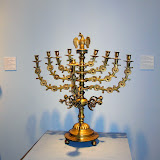 |
| Bill Gross. выставка "Святыня. Искусство. Эстетика" |
The spice box was of little interest to Gross' father-in-law, whose collection was donated to the Spertus Museum in Chicago, but it sparked an obsessive interest in Gross, who spent five years just gathering together books on the subject of Judaica.
Today, Gross' pursuit could be likened to fitting together thousands of pieces of a huge, intricate puzzle: The puzzle of Jewish life.
Whether they originate in Bratslav or Baghdad, the varied pieces in Gross' vast collection "are all readily identifiable as part of the Jewish culture," says the fervent, Minneapolis-born collector, whose sampling of hamsas (hand-shaped talismans, "the ubiquitous symbol of Israel") is currently on display at the Eretz Israel Museum in Tel Aviv. "The essence of Jewish life never changed," he stresses, "and that's what fascinates me."
Despite its amazing variety, his collection attests to the underlying, unifying thread that has been woven through the fabric of Jewish religion and tradition over time, with items such as rimonim (Torah finials) and Torah breastplates instantly recognizable as part of Jewish ritual, regardless of where they were created.
When asked how one goes about putting together such an impressive collection, Gross, 62, confesses, with a big smile, that "it helps to be anally retentive."
He points to a wall of his north Tel Aviv home where part of his collection of hanukkiyot [Hanukkah menorah] is on display, and says they "may not necessarily be the most aesthetic pieces, but they are hanukkiyot that represent various traditions." Gross puts much effort into building up "collections within collections," assembling together as many types of a particular item as possible, for example spice boxes, from one Jewish community.
"I like to be surrounded by my collection," he says, sitting on a couch in his apartment, encircled by glass cabinets containing his treasures. Only on extremely rare occasions, however, do the components of the entire Gross family collection ever come together, as they are frequently loaned out to museums and exhibitions around the world.
For example, the "Journey to a World Without End" exhibit, currently in Frankfurt, is made up of Jewish and Hebrew manuscripts belonging to Gross, which reflect the local culture of Jews in 33 very different cities. The exhibit will arrive in Israel around the time of the High Holy Days this fall.
Paper vs. pewter
Bill Gross, his wife, Lisa, and their young daughter immigrated to Israel in 1969, and he entered the diamond trade.
The collection process gathered steam in the 1970s and 1980s, and he has spent the last decade since retiring preparing exhibitions, and researching and categorizing his artwork. While Gross says he acquired most of the pieces through dealers and auctions, he himself rarely sells items, preferring instead to trade: "I'm not really enamored with the commercial side of it," he explains, adding, "most other collectors are friends of mine and it is very hard to do business with friends."
Gross refused to be cornered into picking a favorite item, saying that it would be like having to choose a favorite child. Under pressure, though, he did say that the manuscripts and paper art, such as ketubot [marriage contracts], are "almost my favorite part of the collection, if I had to choose," since they reflect Jewish life the most accurately. The silver and even pewter items that most people automatically associate with Judaica were owned and/or donated by only a tiny percentage of the communities, as they were often far beyond the meager means of the average Jew.
The onset of affordable printing meant widespread availability of portraits of great rabbis, or depictions of scenes from the Bible. The manuscripts are also important because "they were done by Jews for Jews," Gross explains, unlike the silver objects, such as the rimonim, which, at least in European communities, were made by non-Jews and were often copies of church pieces. In contrast, most silversmiths in the Islamic countries were Jews as the work was considered "dirty" and beneath the dignity of the Muslims.
"In the 18th and 19th centuries, every Jew dreamed of bringing something to press - [the paper art] all reflects the Jewish ethos which the silver work fails to reflect," explains Gross.
Gross often throws his home open to collectors, but most importantly, he invites students just entering the field of Jewish art. He has friends who teach at Hebrew University, Bar-Ilan University and the Seminar Hakibbutzim Teachers College who bring their students to him once a year to get up-close and personal with the real thing.
"Otherwise," he says with some distaste, "they learn Jewish art from slides and books." Allowing the students to become acquainted with the items' physical presence, what they feel like, their weight and other characteristics, adds Gross, "gives them a whole different viewpoint."
Комментариев нет:
Отправить комментарий